Spiderwort
by Valerie (May 7, 2000)
revised August 10, 2003
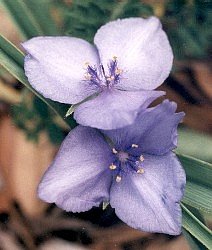 Often thought of as weeds because of the tendency of some species to spread uncontrollably with long, messy foliage, the spiderwort family (Commelinaceae) contains a number of very attractive plants. Spiderworts (Tradescantia sp.) and dayflowers (Commelina sp.) are closely related but the latter tend to have fewer blossoms at a time and longer stems. Their flowers also look like little faces and only two petals are prominent. In contrast, the spiderworts sometimes have large clusters of flowers, which are more symmetrically shaped with three equal petals. The colors of the blossoms range from very light blue to pink to deep blue or purple. 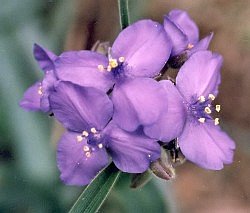
Our gardens include both the sprawling dayflower, which I like because of its pretty bright blue blossoms, and several species of spiderwort. There are several native spiderworts in our area and, although I can tell that certain plants are different from others, I have never found a good resource to help with positive identifications. The first three photos show plants that might be Tradescantia occidentalis, ohioensis, bracteata, or gigantea. These species all have very similar flowers and the reference books I have either show inconclusive photos or even conflicting pictures.
Other names that I have heard applied to spiderwort are "cow slobber" and "kiss me at the gate." Because dayflowers are so aggressive and tend to spread uncontrollably, other names given to them are mostly unprintable, except the oft-used "weed."
In spite of their hardiness, several of our spiderwort plants have lasted only a few years. They are easily overgrown by other plants and just don't seem to like the conditions in our gardens, especially as they have become shadier with the growth of the trees. Those plants that do survive sprout early in the season, produce blossoms during the spring, and then whither as hot weather sets in.
Although the dayflower, also called widow's tears and monkey flower, can take over by growing all over the other plants, it is rather easy to keep in check by just pulling out the extra stems, while leaving the roots alone to propagate.
A new addition to our gardens just started appearing in the past year. False dayflower, or annual widow's tears (Commelinantia anomala or Tinantia anomala), pictured above at left, grows profusely in wooded areas near us. I had just collected some seed to get it started in our gardens, but the plants were one step ahead of me. At the same time I was planting seeds, small plants that had been growing through the previous winter matured and proved to be the same species. False dayflower is usually an annual that dies in the hot weather, but with sufficient water it survives to the next cold period. The flowers of this plant are amusingly face-like.
The well-known Wandering Jew (Tradescantia zebrina or pendula) is another member of the same family, although the flowers are inconspicous compared to the showy larger blooms on the spiderworts. Of course, the Wandering Jew isn't grown for its blossoms but for its beautiful purple and silver foliage.
Because our winters are so mild, we sometimes have patches of Wandering Jew that live for several years before a hard frost kills them off. The plants' thick stems seem to retain water and the leaves rarely wilt, even though the roots are sparse and short. Currently, we just have small sprigs growing in a few protected areas. We also grow a couple of hardier species similar to Wandering Jew. At right is a spotted-leaf Wandering Jew (Tradescantia sp.), which has dark green leaves with purple spots, and is deciduous and not at all invasive. If not given enough water, it tends to disappear permanently. The flower pictured above at left is purple heart (Tradescantia pallida), an evergreen (or purple) form of spiderwort, which only suffers damage in hard freezes and is very drought tolerant.
One more recent addition to our gardens includes an attractive groundcover which I've tentatively identified as bridal veil (Gibasis geniculata or Tradescantia geniculata). This plant might instead be Tradescantia albiflora, but I could not find an adequate photo of the bridal veil plant typically used in |
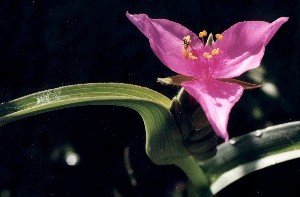 The leaves of all these spiderworts are narrow, long and clasping at the stem. The stems and roots are thick and fleshy, enabling the plants to withstand drought conditions, even if they die back to the ground.
The leaves of all these spiderworts are narrow, long and clasping at the stem. The stems and roots are thick and fleshy, enabling the plants to withstand drought conditions, even if they die back to the ground.
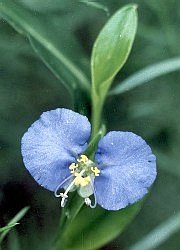
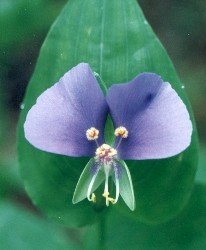 The blue flowers (photo at right) are especially nice during spring when other, later-blooming plants are still just getting started. Erect, or slender, dayflower (Commelina erecta) was very common in our yard when it was sunny. This small-flowered plant loves sun and seems to never wilt, no matter how dry it gets. I often pulled it out as it would crowd other plants. As the shade increased in the gardens, the dayflowers have been reduced to a pleasant accent plant here and there. The foliage of the slender dayflower is rather straggly and weedy looking but the flowers are delightful.
The blue flowers (photo at right) are especially nice during spring when other, later-blooming plants are still just getting started. Erect, or slender, dayflower (Commelina erecta) was very common in our yard when it was sunny. This small-flowered plant loves sun and seems to never wilt, no matter how dry it gets. I often pulled it out as it would crowd other plants. As the shade increased in the gardens, the dayflowers have been reduced to a pleasant accent plant here and there. The foliage of the slender dayflower is rather straggly and weedy looking but the flowers are delightful.
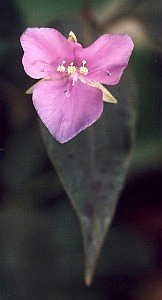
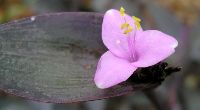
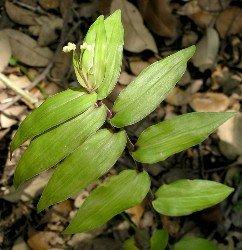
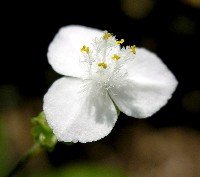 hanging baskets for comparison. This plant sends long runners along the ground and then 6-8" upright stems with fleshy leaves. At the tip of each vertical stem, small white flowers on the ends of thin stems are produced during most of the summer. Our plants have only been in place a couple of years and are still rather sparse, but the effect is one of the blossoms floating above the glossy green leaves. During the winter, the exposed stems and leaves die back, but the stems that are under leaves survive to sprout again in the spring.
hanging baskets for comparison. This plant sends long runners along the ground and then 6-8" upright stems with fleshy leaves. At the tip of each vertical stem, small white flowers on the ends of thin stems are produced during most of the summer. Our plants have only been in place a couple of years and are still rather sparse, but the effect is one of the blossoms floating above the glossy green leaves. During the winter, the exposed stems and leaves die back, but the stems that are under leaves survive to sprout again in the spring.